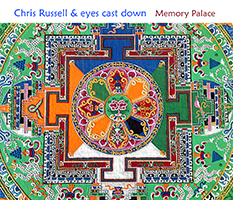
MEMORY PALACE
Chris Russell, eyes cast down
Void Music VM005
/ Kalindi Music KM003
Dec. 8, 2014
| 1. | Primitive and Prime | 11.01 |
| 2. | Spatial Mnemonics | 15.39 |
| 3. | Touchstone Array | 11.05 |
| 4. | Afterimages | 13.46 |
| 5. | Somewhere the Circle Stops | 21.54 |
The five pieces trace a winding path, from the ritual opening of Primitive and Prime, through Touchstone Array‘s electron crackle and the mesmerizing, non-rhythmic interlude Afterimages, into the melting pot of Somewhere the Circle Stops, which alternates odd-meter electronic rhythms with live tribal drumming.
The album artwork is Dasi’s photographs of a Buddhist sand mandala, which was on display at Chicago’s Loyola University in spring 2012.
Review by John Shanahan, Hypnagogue:
Review by Bert Strolenberg, Sonic Immersion:
The first half of the the 5-track/70+ minutes album is centered around electric groove patterns using mostly acoustic drum and percussion samples and the sounding of Greg’s much-favored wooden frogs alongside tasty synth textures and circular atmospheres, all creating quite an intense and more upfront sonic statement with a certain psychedelic edge. The third piece “Touchstone Array” (defined as electron crackle) reveals certain contemplativeness, but evolves eventually into a weird and abstract/experimental effort led by acoustic samples set to a racing tempo with lots of bleeps and sound modifications running alongside.
The result on “Memory Palace” comes down to quite peculiar ambient, expecting the listener to think out of the box quite a bit.